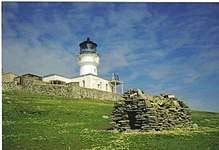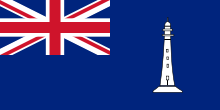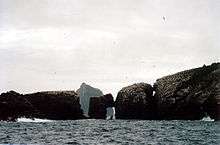Flannan Isles Lighthouse
 The Chapel of St Flannan can be seen on the slope to the right of the lighthouse on Eilean Mòr. | |
 Outer Hebrides | |
| Location |
Eilean Mòr 32 kilometres (20 mi) west of Lewis Western Isles Scotland |
|---|---|
| Coordinates | 58°17′17″N 7°35′16″W / 58.2881°N 7.5879°WCoordinates: 58°17′17″N 7°35′16″W / 58.2881°N 7.5879°W |
| Year first constructed | 1899 |
| Automated | 1971 |
| Construction | masonry tower |
| Tower shape | cylindrical tower with balcony and lantern attached to 1-storey keeper's house |
| Markings / pattern | white tower, black lantern, ochre trim |
| Height | 23 metres (75 ft) |
| Focal height | 101 metres (331 ft) |
| Current lens | 3rd order clamshell Fresnel lens |
| Light source | solar power |
| Range | 20 nautical miles (37 km; 23 mi) |
| Characteristic | Fl (2) W 30s. |
| Admiralty number | A4028 |
| NGA number | 3912 |
| ARLHS number | SCO-084 |
| Managing agent |
Northern Lighthouse Board[1] [2] |
| Heritage |
category B listed building |
Flannan Isles Lighthouse is a lighthouse near the highest point on Eilean Mòr, one of the Flannan Isles in the Outer Hebrides off the west coast of Scotland. It is best known for the mysterious disappearance of its keepers in 1900.
History

The 23-metre (75 ft) lighthouse was designed by David Alan Stevenson for the Northern Lighthouse Board (NLB). Construction, between 1895 and 1899, was undertaken by George Lawson of Rutherglen at a cost of £6,914 inclusive of the building of the landing places, stairs, railway tracks etc. All of the materials used had to be hauled up the 45-metre (148 ft) cliffs directly from supply boats, no trivial task in the ever-churning Atlantic. A further £3,526 was spent on the shore station at Breasclete on the Isle of Lewis.[3] It was first lit on 7 December 1899.
The purpose of the railway tracks was to facilitate the transport of provisions for the keepers and fuel for the light (paraffin, at that date; the light consumed twenty barrels a year) up the steep gradients from the landing places by means of a cable-hauled railway. This was powered by a small steam engine in a shed adjoining the lighthouse. A track descended from the lighthouse in a westerly direction and then curved round to the south. In the approximate centre of the island it forked by means of a set of hand-operated points humorously dubbed "Clapham Junction"; one branch continued in its curvature to head eastwards to the east landing place, on the south-east corner of the island, thus forming a half-circle, while the other, slightly shorter, branch curved back to the west to serve the west landing, situated in a small inlet on the island's south coast. The final approaches to the landing stages were extremely steep. The cable was guided round the curves by pulleys set between the rails, and a line of posts set outside the inner rail prevented it from going too far astray should it jump off the pulleys. The cargo was carried in a small four-wheeled bogie.[4]
In 1925, the lighthouse was one of the first Scottish lights to receive communications from the shore by wireless telegraphy.[5] In the 1960s, the island's transport system was modernised. The railway was removed, leaving behind the concrete bed on which it had been laid to serve as a roadway for a "Gnat" – a three-wheeled, rubber-tyred cross-country vehicle powered by a 400cc four-stroke engine, built by Aimers McLean of Galashiels. This had a somewhat shorter working life than the railway, becoming redundant in its turn when the helipad was constructed.[6]
On 28 September 1971, the lighthouse was automated. A reinforced concrete helipad was constructed at the same time to enable maintenance visits in heavy weather. The light is produced by burning acetylene gas and has a range of 17 nautical miles; 20 miles (32 km). It is now monitored from the Butt of Lewis[7] and the shore station has been converted into flats.[8]
Disappearances in 1900
Discovery

The first record that something was untoward on the Flannan Isles was on 15 December 1900 when the steamer Archtor, on a passage from Philadelphia to Leith, noted in its log that the light was not operational in poor weather conditions. When the ship docked in Leith on 18 December 1900, the sighting was passed onto the Northern Lighthouse Board.[9] The relief vessel, the lighthouse tender Hesperus, was unable to sail from Breasclete, Lewis as planned on 20 December due to adverse weather. It was not until noon on Boxing Day (26 December) that it reached the island.[7] The lighthouse was manned by three men: Thomas Marshall, James Ducat, and Donald MacArthur, with a rotating fourth man spending time on shore.
On arrival, the crew and relief keeper found that the flagstaff had no flag, none of the usual provision boxes had been left on the landing stage for re-stocking, and more ominously, none of the lighthouse keepers were there to welcome them ashore. Jim Harvie, the captain of the Hesperus, attempted to reach them by blowing the ship's whistle and firing a flare but was unsuccessful.
A boat was launched and Joseph Moore, the relief keeper, was put ashore alone. He found the entrance gate to the compound and main door both closed, the beds unmade, and the clock stopped. Returning to the landing stage with this grim news, he then went back up to the lighthouse with Hesperus's second-mate and a seaman. A further search revealed that the lamps were cleaned and refilled. A set of oilskins was found, suggesting that one of the keepers had left the lighthouse without them, which was surprising considering the severity of the weather on the date of the last entry in the lighthouse log. The only sign of anything amiss in the lighthouse was an overturned chair by the kitchen table. There was no sign of any of the keepers, neither inside the lighthouse nor anywhere on the island.[7][10]
Moore and three volunteer seamen were left to attend the light and Hesperus returned to Lewis. Captain Harvie sent a telegram to the Northern Lighthouse Board dated 26 December 1900, stating:
A dreadful accident has happened at the Flannans. The three keepers, Ducat, Marshall and the Occasional have disappeared from the Island... The clocks were stopped and other signs indicated that the accident must have happened about a week ago. Poor fellows they must have been blown over the cliffs or drowned trying to secure a crane.[7][10]
On Eilean Mòr, the men scoured every corner of the island for clues as to the fate of the keepers. They found that everything was intact at the east landing but the west landing provided considerable evidence of damage caused by recent storms. A box at 33 metres (108 ft) above sea level had been broken and its contents strewn about; iron railings were bent over, the iron railway by the path was wrenched out of its concrete, and a rock weighing more than a ton had been displaced. On top of the cliff at more than 60 metres (200 ft) above sea level, turf had been ripped away as far as 10 metres (33 ft) from the cliff edge. The missing keepers had kept their log until 9 a.m. on 15 December. The entries made it clear that the damage had occurred before their disappearance.[7][11]
Speculation and conjecture
No bodies were ever found, resulting in "fascinated national speculation" in newspapers and periodicals of the period.[12] Implausible stories ensued, such as that one keeper had murdered the others, then thrown himself into the sea; a sea serpent (or giant seabird) had carried the men away; they had been abducted by foreign spies; or they had met their fate through the malevolent presence of a boat filled with ghosts (the baleful influence of the "Phantom of the Seven Hunters" was widely suspected locally).[7] More than ten years later, the events were still being commemorated and elaborated on. The 1912 ballad Flannan Isle by Wilfrid Wilson Gibson refers erroneously to an uneaten meal laid out on the table, indicating that the keepers had been suddenly disturbed.[13]
Yet, as we crowded through the door,
We only saw a table spread
For dinner, meat, and cheese and bread;
But, all untouch'd; and no-one there,
As though, when they sat down to eat,
Ere they could even taste,
Alarm had come, and they in haste
Had risen and left the bread and meat,
For at the table head a chair
Lay tumbled on the floor.[14]
However, in a first-hand account made by Moore, the relief keeper, he stated that: "The kitchen utensils were all very clean, which is a sign that it must be after dinner some time they left."[7]
Northern Lighthouse Board investigation

On 29 December 1900, Robert Muirhead, a Northern Lighthouse Board (NLB) superintendent, arrived to conduct the official investigation into the incident. He examined the clothing left behind in the lighthouse and concluded that James Ducat and Thomas Marshall had gone down to the western landing stage, and that Donald MacArthur (the 'Occasional') had left the lighthouse during heavy rain in his shirt sleeves. He noted that whoever left the light last and unattended was in breach of NLB rules.[7] He also noted that some of the damage to the west landing was "difficult to believe unless actually seen".[13]
From evidence which I was able to procure I was satisfied that the men had been on duty up till dinner time on Saturday the 15th of December, that they had gone down to secure a box in which the mooring ropes, landing ropes etc. were kept, and which was secured in a crevice in the rock about 110 ft (34 m) above sea level, and that an extra large sea had rushed up the face of the rock, had gone above them, and coming down with immense force, had swept them completely away.[15]
Whether this explanation brought any comfort to the families of the lost keepers is unknown. The deaths of Thomas Marshall, James Ducat (who left a widow and four children), and Donald MacArthur (who left a widow and two children) cast a shadow over the lighthouse service for many years.[13]
Later theories and interpretations

Subsequent researchers have taken into account the geography of the islands.[7] The coastline of Eilean Mòr is deeply indented with narrow gullies called geos. The west landing, which is situated in such a geo, terminates in a cave. In high seas or storms, water would rush into the cave and then explode out again with considerable force. It was possible MacArthur may have seen a series of large waves approaching the island, and knowing the likely danger to his colleagues, ran down to warn them only to be washed away as well in the violent swell.[16] This theory has the advantages of explaining the over-turned chair and the set of oilskins remaining indoors,[7] although perhaps not the closed door and gate.[17] Another theory is based on the first-hand experiences of Walter Aldebert, a keeper on the Flannans from 1953 to 1957. He believed one man may have been washed into the sea but then his companions, who were trying to rescue him, were washed away by more freak waves.[17] A further proposal is based on the psychology of the keepers. Allegedly MacArthur was a volatile character; this may have led to a fight breaking out near the cliff edge by the West Landing that caused all three men to fall to their deaths.[18]
Among modern theories are those connected to paranormal activity, such as abduction by aliens.[12] Fictional use of this premise was featured in the Doctor Who serial Horror of Fang Rock.[19] The mystery also was the inspiration for the composer Peter Maxwell Davies's modern chamber opera The Lighthouse (1979).[20] The British rock group Genesis wrote and recorded "The Mystery of Flannan Isle Lighthouse" in 1968 while working on their first album, but it was not released until 1998 in Genesis Archive 1967–75.[21]
See also
- List of lighthouses in Scotland
- List of Northern Lighthouse Board lighthouses
- Mary Celeste, a ship whose crew disappeared entirely, leading to similar theorizing about the cause.
- List of people who disappeared mysteriously
- Draupner wave
Notes
- ↑ Flannan Islands (Eilean Mor) The Lighthouse Directory. University of North Carolina at Chapel Hill. Retrieved 18 May 2016
- ↑ Flannan Islands Northern Lighthouse Board. Retrieved 18 May 2016
- ↑ "Flannan Isles Lighthouse " Northern Lighthouse Board. Retrieved 23 March 2008.
- ↑ Atkinson, Robert (1949). Island Going. Collins.
- ↑ Munro 1979, p. 223.
- ↑ "A Gnat on the Flannans". 2011-06-29. Retrieved 2013-06-24.
- 1 2 3 4 5 6 7 8 9 10 Christopher Nicholson (1995). Rock Lighthouses of Britain: The End of an Era?. pp. 168–79.
- ↑ Perrot, D. et al. (1995) p. 132.
- ↑ "Archtor: Caiplie, Firth Of Forth". www.canmore.org.uk. Retrieved 26 December 2017.
- 1 2 "Transcripts from documents related to the Flannan Isles mystery." Museum of Scottish Lighthouses/Wayback. Original retrieved 3 September 2008, Wayback version retrieved 7 December 2013.
- ↑ Munro 1979, pp. 170–71.
- 1 2 Bathhurst (2000) p. 249.
- 1 2 3 Munro (1979) p. 171.
- ↑ Quotation from Nicholson (1995) p. 178.
- ↑ Munro (1979) pages 170–71, although Nicholson (1995), Bathhurst (2000) and Haswell-Smith (2004) quote the same report using somewhat different language: "After a careful examination of the place.... I am of the opinion that the most likely explanation of the disappearance of the men is that they had all gone down on the afternoon of Saturday, 15 December to the proximity of the west landing to secure the box with the mooring ropes etc. and that an unexpectedly large roller had come up on the island, and that a large body of water going up higher than where they were and coming down upon them, swept them away with resistless force.”
- ↑ Haswell-Smith (2004) suggests these events are "very rare".
- 1 2 Haswell-Smith, Hamish (2004). The Scottish Islands. Edinburgh: Canongate. pp. 329–31. ISBN 978-1-84195-454-7.
- ↑ McCloskey, Keith (2014). The Lighthouse: The Mystery of the Eilean Mor Lighthouse Keepers. History Press. ISBN 978-0750953658.
- ↑ "The Mystery of Flannan Isle". www.bbc.co.uk. Retrieved 23 March 2008.
- ↑ "Opera: The Lighthouse by Davies". The New York Times. Retrieved 8 October 2008. .
- ↑ "The Mystery Of The Flannan Isle Lighthouse (Demo 1968)". www.Yahoo.com. Retrieved 8 July 2008.
References
- Munro, R.W. (1979). Thule Press, ed. Scottish Lighthouses. Stornoway.
- Keith McCloskey (2014) The Lighthouse: The Mystery of the Eilean Mor Lighthouse Keepers History Press
External links
| Wikimedia Commons has media related to Flannan Isles Lighthouse. |